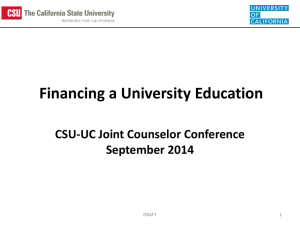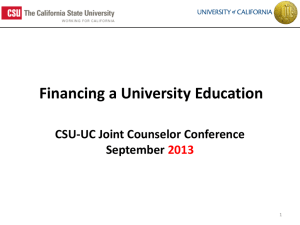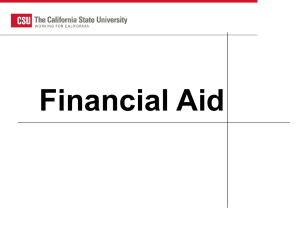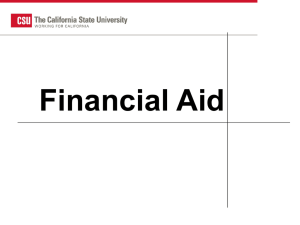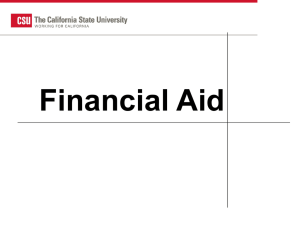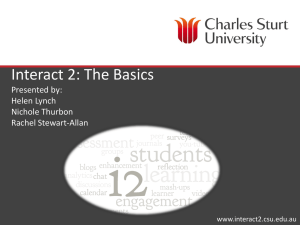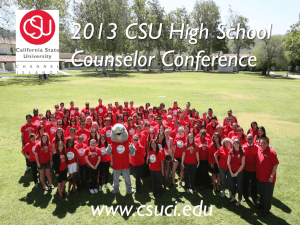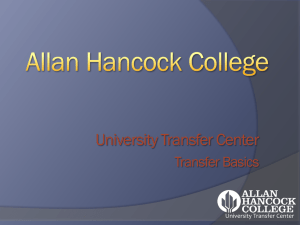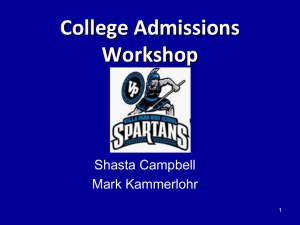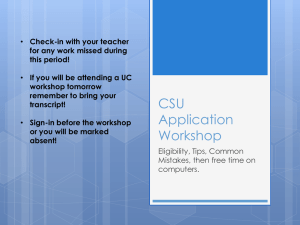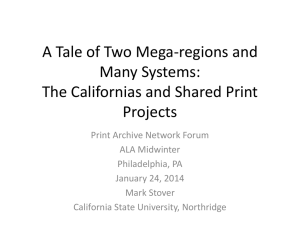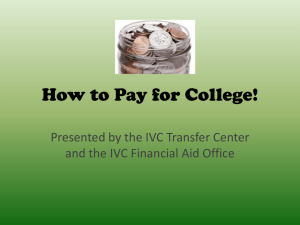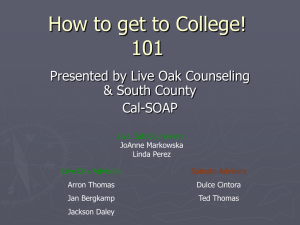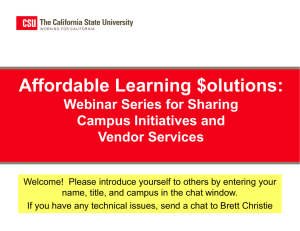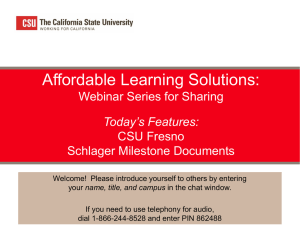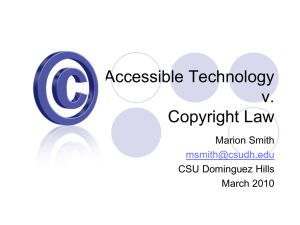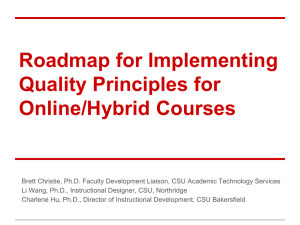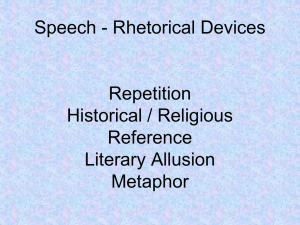Special Population Session: AB 540 & Undocumented Students
advertisement
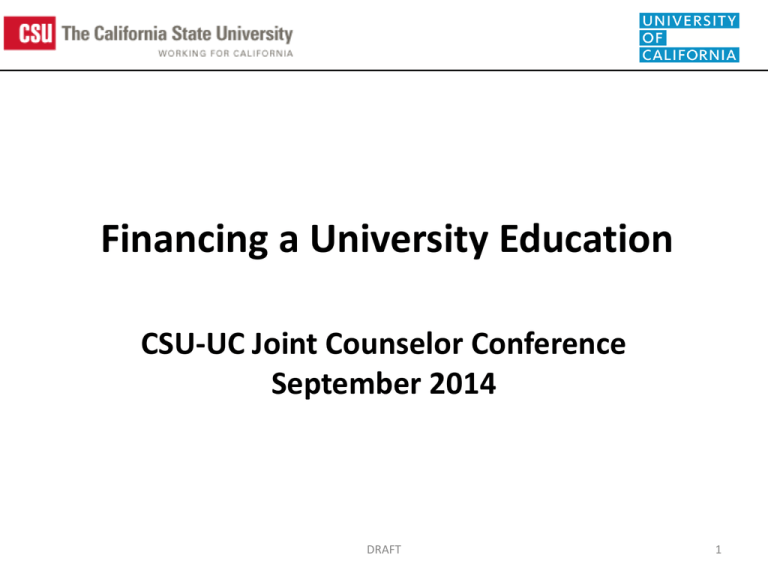
Financing a University Education CSU-UC Joint Counselor Conference September 2014 DRAFT 1 California Students Can Afford College • Help is available! • • • • Federal grants Student loans State grants University grants • • • • Parent loans Private and State scholarships Part-time work Higher education tax credits • Both UC & CSU enroll a large number of lowincome students, few of whom pay the “sticker price” - concentrate on the “net price” instead! DRAFT 2 How to Apply • It takes two! • File the FAFSA OR California Dream Application • High school or student file Cal Grant GPA verification form • March 2nd is the priority deadline • FAFSA & Dream Applications available beginning Jan 1 • Student and parent can sign the FAFSA with a federal “PIN” • California Dream Application also allows the student and parent to sign the application electronically DRAFT 3 What Happens Next • Respond immediately to all requests for followup documents and actions, including those from both the financial aid and admissions offices • Find out how the college will communicate with the student – many rely on student checking their email and on-line portals for document requests, other action, and award notices • Families should hear about their award in time to make an informed decision PRIOR TO THE DATE on which university asks them to commit (often May 1 for freshmen and later for transfers) DRAFT 4 Financing College is a Partnership Students contribute through working and borrowing Parents are asked to contribute based on their financial strength Low-income parents often asked to contribute zero Some students are “independent” of their parents – over 1/3 at the CSU (over age 24, dependents of their own, etc.) Universities pull together financial aid for students Offer a combination of federal, state, and university grant and scholarship to eligible students Assist families seeking loans to help meet their contribution DRAFT 5 Working and Borrowing • All student seeking financial aid at CSU and UC are expected to work part time and to borrow reasonable amounts that result in “manageable” student loan debt. • A work study job as well as other jobs on or off campus are both roughly equivalent ways that students can contribute to their support from earnings. • Working more than half time while enrolled full time is associated with declining academic performance. DRAFT 6 CSU UC Many students work at least half time and enroll less than full time Most students work half time or less and enroll full time Sticker price is about $6,500, but the average net amount paid by undergraduates is about $2,400 Financial aid reduces price differential between the cost of CSU and UC for grant recipients At CSU, average student loan indebtedness for 2012 graduates was about $18,460 (about $193 per month for 10/yrs) At UC, average student loan indebtedness for 2012 graduates was about $20,600 (about $230 per month for 10/yrs) Typical time-to-degree for entering freshman is 5.3 years. Typical time-to-degree for entering freshman is 4.2 years Typical time to degree for entering Typical time to degree for entering junior transfer student is 3.3 years junior transfer student is 2.4 years DRAFT 7 Costs of Attending CSU and UC 2014-2015 California State University 2014-15 Fees Books & Supplies University of California At Home On Campus Off Campus $6,698 $6,698 1,719 1,719 2014-15 At Home On Campus Off Campus $6,698 Fees $13,300 $13,300 $13,300 1,719 Books & Supplies 1,500 1,500 1,500 4,600 14,000 9,300 Room & Board 4,532 12,080 12,089 Room & Board Transp. 1,345 1,169 1,391 Personal & Transp. 3,700 2,400 3,100 Personal 1,364 1,364 1,364 Health Ins. 1,600 1,900 2,000 $15,658 $23,030 $23,261 $24,700 $33,100 $29,200 TOTAL TOTAL Most families do not pay the “sticker price” DRAFT 8 CSU and UC are Affordable For families paying “full sticker price,” per year, CSU is on average $9,075 less for commuters, $10,104 less for students living on our campuses, and $5,885 less for students living off campus, but not with family. This annual cost differential between CSU and UC may be slightly less for financial aid recipients. UC budgets also include around $1,900 per year for student health care. Most of this amount is for health insurance; UC students can waive out of paying for UC student health insurance if they are covered under a non-UC policy. UC expects full-time enrollment and part-time work; CSU is more flexible About half of undergraduate students take out student loans at UC and CSU Public institutions in California are the best educational bargains, especially for low-income students Most students enrolled in private colleges and universities take out student loans and graduate with higher average student loan debt than students who graduate from public institutions, no matter the time to degree or other DRAFT 9 factors! Federal Education Tax Credits • To the extent that students or their families pay their tuition, certain required fees, qualified books and supplies out of their own pockets (without grant or scholarship), they may apply for a federal education tax credit of up to $2500 on the first $5000 that they pay out of pocket. • A tax credit reduces the amount of taxes owed! • Rather than wait for an income tax refund, families eligible for the federal American Opportunity Tax Credit can reduce the amount that is withheld incrementally each pay period so that they have the extra cash when they most need it to pay college expenses. DRAFT 10 BLUE AND GOLD at UC • Undergraduate California residents who file FAFSA or DREAM applications on time and are determined to have financial need and total family incomes under $80K per year will not have to pay UC’s systemwide tuition and fees ($12,192 in 2014-15) out of their own pockets for the first four years (two years for transfers) that they are enrolled at UC. • Eligible students may qualify for additional grant support to help pay for other college expenses. DRAFT 11 California DREAM Application • https://dream.csac.ca.gov/ • Must be eligible for AB 540 status, even if AB 540 certification has not been completed at the time of application • Males must have registered for the Selective Service before age 26 • DACA eligibility doesn’t play a role; DACA SSN is not used for any purpose other than work • Student or parent may be required to verify income, even if taxes have not been filed DRAFT 12 Middle Class Scholarship – “MCS” at CSU and UC • A state-funded scholarship for CA residents and DREAMers from families with “total” incomes up to $150K • Students must file a FAFSA/DREAM Application by March 2 • MCS will cover between 10% up to 40% of systemwide tuition and fees – percent varies with total income • Each year award amount will increase until 2017-18 when it reaches 40% of systemwide tuition and fees if state funds are sufficient • The MCS award will be reduced by any Federal, State, or institutionally administered grants or fee waivers received by the student • Student must be enrolled at least half time (6 units) • Student must maintain satisfactory academic progress DRAFT 13 Resources CSU Financial Aid Information: http://www.calstate.edu/SAS/sfa_index.shtml UC Financial Aid Information: http://www.universityofcalifornia.edu/admissions/paying.html FAFSA and federal PIN Information - www.fafsa.ed.gov Cal Grant and MCS Information - www.csac.ca.gov or 1-888-224-7268 California DREAM application - https://dream.csac.ca.gov/ What will my monthly repayment be for student loans? http://studentaid.ed.gov/repayloans/understand/plans/standard/comparison-calculator DRAFT 14
